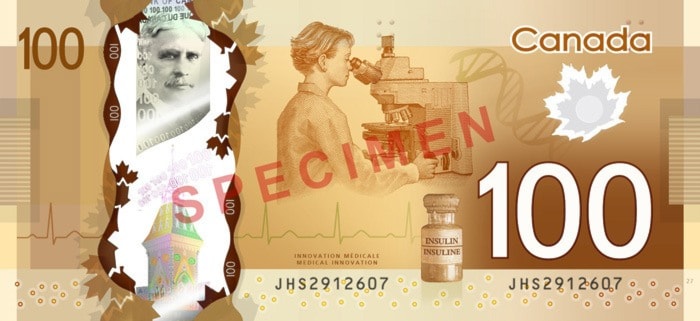New plastic bank notes will be hitting the market this November, as the Canadian treasury ramps up action against counterfeiting.
A sneak peek of the new bills took place in Surrey on Monday. The $100 bill, which will be released this November, has two transparent areas on the note. Looking through the smaller one at a single source of light, numbers appear that correspond with the value of the bill.
The larger transparent area has a picture of the House of Commons and numbers in holographic image, which is extremely complicated to reproduce.
The $100 bill, like its predecessor, has a picture of Sir Robert Borden, the prime minister between 1911 and 1920, while two-time prime minister William Lyon Mackenzie King remains on the $50 bill.
New to the $100 bill are images of Canada's role as a pioneer in medicine for the discovery of insulin, and the invention of the pacemaker.
The $50 note, which will be released in March, 2012, displays the image of the Canadian Coast Guard Ship Amundsen in the North, reflecting this country's role in Arctic research.
The remaining Canadian bills will be released subsequently, beginning with the $20 note at the end of next year and the remaining in 2013.
Other distinguishing features on the bills include:
• $20: The Canadian National Vimy Memorial – evokes the contributions and sacrifices of Canadians in conflicts throughout our history. (Portrait: Queen Elizabeth II).
$10: The Canadian train – represents Canada's technical feat of linking its eastern and western frontiers by what was, at the time, the longest railway ever built. (Portrait: Sir John A. Macdonald).
$5: Canadarm2 and Dextre – symbolize Canada's continuing contribution to the international space program through robotics innovation. (Portrait: Sir Wilfrid Laurier).
The cost of the transition to the new notes include $20 million in research and development. It will also cost 19 cents to produce each bill, as opposed to the 10 cents apiece for those already in circulation.
The new bills are expected to last 2.5 times as long as their predecessors, reducing processing costs and impact on the environment.
For more information visit www.bankofcanada.ca/banknotes
@diakiw
